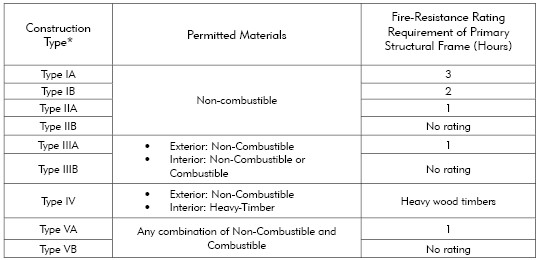Adding Wood Framed Structures to Metal Buildings
 * Type A buildings will have a higher fire-resistance rating for structural elements than Type B. With the exception of Type I, Type A is commonly referred to as a protected building and Type B is referred to as an unprotected building. Please note that protected and unprotected does not indicate whether or not an automatic sprinkler system is installed.
* Type A buildings will have a higher fire-resistance rating for structural elements than Type B. With the exception of Type I, Type A is commonly referred to as a protected building and Type B is referred to as an unprotected building. Please note that protected and unprotected does not indicate whether or not an automatic sprinkler system is installed.
8 years, 7 months ago

By Ellen McCulley, AIA, LEED AP, NCARB
Nelson Design, Inc.
We visit a lot of industrial facilities and occasionally encounter a wood framed mezzanine that has been added inside a steel building after the original construction. This modification alters the construction type for the entire building and can create significant issues with regard to fire risk and building code compliance.
Under the International Building Code (IBC), every building is classified as one construction type which is determined by the least safe type of construction utilized in the building. The types of construction defined in the IBC are listed in the table below from safest to riskiest.
The International Building Code classifies non-fireproofed steel buildings as Type IIB construction. In order for a building to be classified as Type IIB, the primary structural frame, walls, roof, and floor must be constructed of non-combustible materials (with some exceptions). When a wood frame structure is added inside an otherwise Type IIB building, the construction type changes from a Type IIB to a Type VB. Construction Type VB allows the building elements previously mentioned to be built out of either non-combustible or combustible materials.
As a result of allowing combustible materials, Type VB buildings are far more limited in size, height, and stories than Type IIB. For example, in factory and storage occupancies which are commonly found in industrial buildings, Type VB buildings are restricted to one less story, fifteen feet less in height, and approximately half of the square footage of a Type IIB.
Therefore, before a wood framed structure is added to an existing Type IIB building, the entire building must be carefully evaluated to ensure it can meet the more stringent code requirements for a Type VB.
ABOUT THE AUTHOR
Ellen McCulley graduated magna cum laude with a Bachelor of Architecture from Iowa State University where she received the Pella Architectural Award from the Department of Architecture. She is a registered architect in Iowa and Illinois. Ms. McCulley joined Carl A. Nelson & Company in 2012. Learn more by calling Ellen at 319-754-8415, or write to canco@carlanelsonco.com.